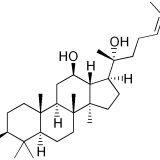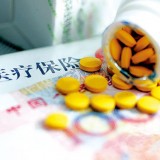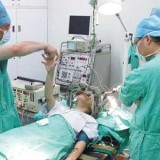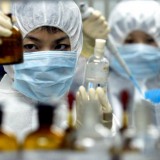Non-small-cell lung carcinoma (NSCLC) is any type of epithelial lung cancer other than small cell lung carcinoma (SCLC). The American Cancer Society’s estimates for lung cancer in the United States for 2014 are:
- About 224,210 new cases of lung cancer (116,000 in men and 108,210 in women)
- An estimated 159,260 deaths from lung cancer (86,930 in men and 72,330 among women).
Lung cancer accounts for about 27% of all cancer deaths and is by far the leading cause of cancer death among both men and women. Each year, more people die of lung cancer than of colon, breast, and prostate cancers combined.
Although chemotherapy is being used both pre-operatively (neoadjuvant chemotherapy) and post-operatively (adjuvant chemotherapy), NSCLCs are relatively insensitive to chemotherapy, compared to small cell carcinoma. Therefore, to find new chemo regimens and conquer its resistance is increasingly becoming the focus of current NSCLC research.
20(s)-protopanaxadiol (PPD) can be isolated from American ginseng (Panax quinquefolium L.), and sevral studies have demonstrated its strong anti-cancer activity on a number of cancer cells. In this study, Dr. Zhang applied PPT to non-small cell lung cancer, and found PPT also quickly triggered cancer cell death.
The study used fluorescence stainning, gel electrophoresis, and flow cytometry to investigate the PPD influence on NSCLC cells. Several other complicated technologies were also employed to explore the underlining mechanisms. With PPD treatment, NSCLC cells underwent noticeable apoptosis dose- and time-dependently. Some anti-apoptosis genes like Bcl-1/bax were inhibited, and pro-apoptosis chemicals (e.g., cytochrome C, AFI, Smac, etc.) leaked from mitochondria to trigger cascade reactions of caspase activation (caspases are enzymes stimulating apoptosis).
Besides, PPD shut down the signaling pathways of cancer cell survival. A kinase named AKT, which stimulates cell growth and division, was significantly inhibited. AKT inhibitor could synergistically enhanced PPD’s pro-apoptotic effect on NSCLC cells.
In summary, through inhibition of PI3K/AKT signaling pathway, PPD induces NSCLC cell apoptosis, implying PPD’s therapeutical potential in NSCLC treatment.
Above results are extracted from Dr. Rui Zhang’s doctoral dissertation “20(s)-protopanaxadiol induces apoptosis of NSCLC A549 cells by inhibition of P13K/AKT signaling pathway” (2009, Jilin University, China).














































